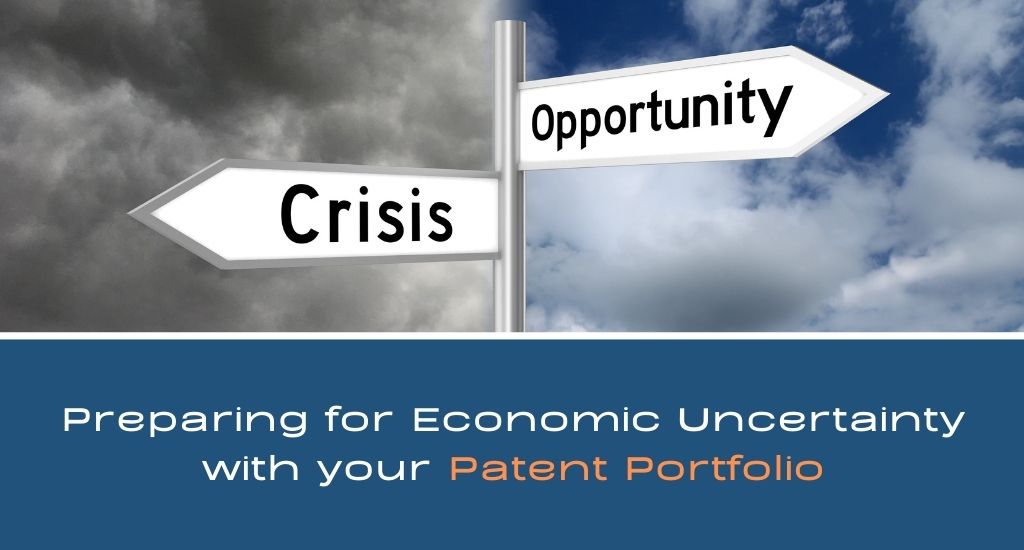- July 22, 2022
- Posted by: mbipuser
- Categories: Ip Topics, Latest article

Economic Uncertainty? Weather the Storm with Patents!
Preparing for Economic Uncertainty with your Patent Portfolio
It is currently summer, but winter is just around the corner. For the second straight quarter of 2022, venture capital funding fell more than 20%. Investors have pulled back on deals by as much as 15% in the first quarter of 2022, especially for startups. Births of unicorn companies have declined 43% from their peak in 2021. With economic uncertainty, it is only natural for companies to consider how to conserve their resources to weather the storm.
When companies make budget cuts to conserve resources, the intellectual property (IP) budget is an easy target. All startups are trying to increase their runway by removing non-essential expenses, and it is readily assumed that patents, which take a long time to mature, can be delayed. This is a common response to economic downturns, as companies do not see immediate value in their patents and decide that this is where to start cutting. However, decades of experience and data have shown that this is incorrect – diminishing patent budgets by too much in the short term often hurts a company in the long-term. Instead of rushing to slash the patent budget, founders looking to conserve funds during economic uncertainty should weigh their options and understand the ramifications of divesting from IP spending. Often, they should focus on optimizing their patent spending to maximize the impact of a more limited budget.
What are the risks of abandoning your patent portfolio during an economic downturn?
1. Cash flow – IP can be leveraged to raise capital. There are a few ways in which patents can be leveraged like other assets, such as licensing, or even selling them. Additionally, patents are commonly used as collateral for a loan. This option may be helpful to maintain the number of patent filings for a company while also using those patent filings to generate investments. In 2013, Alcatel-Lucent was able to secure a $2B line of credit as a lifeline for the company, based entirely on their strong IP portfolio.
Like any other security interest, companies must be prepared to pay back the loan or risk losing the collateral patents.
2. Valuation – Strong patent portfolios tend to improve valuations of startups during fundraising. Companies that are able to keep a number of key patents may be able to raise more capital. As noted above, the goal for maintaining your patent rights should be to optimize your spending, not cut it out entirely. Companies which focus their spending will ideally be raising more money in funding than is being spent on patents regularly.
3. Disclosure – If your company is still developing technology, there is a chance that you may disclose your invention to investors or other individuals not within an organization. Disclosing those inventions without any patent protection can potentially make your invention unpatentable. Patent law favors those who file patents earlier, so companies may lose the ability to protect their core innovations by cutting the IP budget entirely. Additionally, patents take a long time to grant, and conditions may be different when they are eventually granted.
4. Competition – Not filing patents in a timely manner may allow competitors to gain a competitive advantage in your industry. Competitors will also be looking to increase their patent portfolio, and any lack of filings could result in your technology being improved upon, or completely adopted, by others.
Increase your Runway for a safe take-off!
When increasing their runway, companies can utilize a few patent strategies to maximize their chances of successfully surviving. Again, the goal is to keep your existing patent portfolio strong even with a responsible budget.
Here are some recommendations on how to keep your existing patent portfolio strong within a budget:
1. Align your IP spending with your current patent strategy. This can change throughout a startup’s lifecycle, so it is important to realign your strategy on a regular basis. If your current patents do not align with your current goals, consider cleaning up your patent portfolio invention-by-invention. Look at each patent application you have filed and consider how valuable the invention covered by that patent application is compared to the anticipated cost of obtaining a patent. For pending patent applications that are not yet patents, consider how much more prosecution might cost. For example, the cost of responding to each office action, how many office actions have already been received, how long the application has been pending, and whether the arguments have been making progress with the examiner. If it appears that a particular application is still far from being granted and is not sufficiently important to justify continuing to spend money, consider letting it go abandoned. The same goes for granted patents, so consider the importance of a patented invention as compared to the ongoing maintenance fees for the patent and decide whether the cost/benefit analysis favors keeping each patent.
2. Scrutinize foreign filing expenses. For many industries, the US is one of the most important markets to have patent protection in, but companies may file counterpart foreign applications in other countries almost without thought. Reevaluate how valuable each market is and how useful having patents may be in those markets. This can help you decide if a given foreign patent is worth spending more money on. Patents may provide little return for investment in certain markets and these markets may not be worth continuing to spend money on patents in.
3. Manage your attorney time wisely. Consider cost management solutions for your current representation. Ask whether costs can be capped and/or if flat fees can be charged for activities like
filing office action responses or information disclosure statements. Make sure that all documentation is filed on time to save on unnecessary fees.
4. Delay prosecution costs. This may help conserve resources while waiting for the economy to rebound and can allow you more time to consider markets in which you want patent coverage. US provisional patent applications must be converted into US non-provisional applications within one year of filing, but during that year, the US patent office will not issue office actions that you need to respond to. Similarly, filing a PCT/international application allows you to delay filing in specific countries for a total of around 30 months from the initial filing. The main downside to this approach is that, although you can put off costs, no patent will be granted until a patent application is examined in the country in which it is filed. Thus, this strategy tends to be best for inventions that are not expected to be critical for blocking competitors.
5. Look for hidden costs of obtaining patents. The real cost of obtaining patents lies not only in the attorney and government fees, but more importantly in the opportunity cost by inventors spending time on patent disclosures and office action responses instead of developing products and features. When reevaluating your patent strategy, look for ways to minimize the time spent by inventors on patents. This may include seeking out practitioners who can effectively draft accurate patent applications without lengthy disclosures. A slightly more expensive patent professional who saves your engineers a lot of time can help to minimize the true cost of your patents in the long run.
Most importantly, invest in the future! Even if things look uncertain today, don’t abandon your company’s long-term plans. Companies need to make tough decisions about their assets – rather than indiscriminately cutting costs, they should consider which assets will be most important in the future and plan accordingly. By closely examining your inventions and costs, you can minimize your spending
on patents without sacrificing your most critical patent rights. Companies that succeed on this front improve their chances of surviving economic downturns without hurting their long-term prospects.
We know it can be daunting to maintain a patent portfolio (and cash from starting up likely will run out eventually). M&B has decades of experience in helping companies navigate economic downturns while minimizing long-term impacts. With a track record of providing excellent service that saves inventors time as well as a transparent fee structure, we are confident that we can help you navigate any challenge. Please contact us if you would like to find out more about getting the most out of your patents for less.
*Any information in this article is not legal advice. No reader should act or refrain from acting based on information provided herein without seeking appropriate professional advice based on the particular facts and laws that may apply. Nothing in this article is intended to, and nothing herein does create, an attorney-client relationship with M&B IP Analysts, LLC
